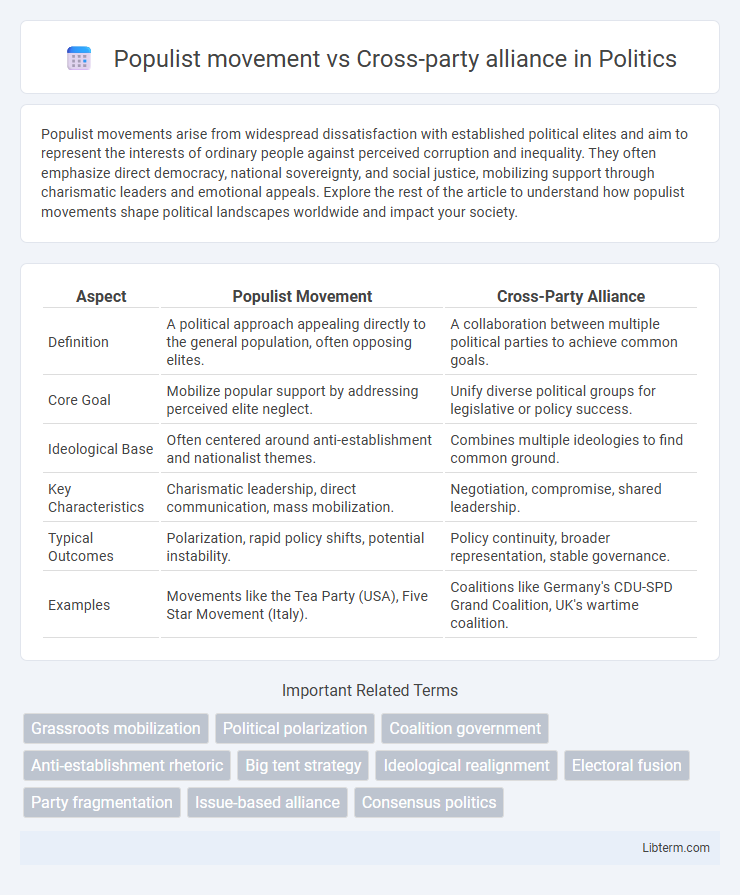Populist movements arise from widespread dissatisfaction with established political elites and aim to represent the interests of ordinary people against perceived corruption and inequality. They often emphasize direct democracy, national sovereignty, and social justice, mobilizing support through charismatic leaders and emotional appeals. Explore the rest of the article to understand how populist movements shape political landscapes worldwide and impact your society.
Table of Comparison
| Aspect | Populist Movement | Cross-Party Alliance |
|---|---|---|
| Definition | A political approach appealing directly to the general population, often opposing elites. | A collaboration between multiple political parties to achieve common goals. |
| Core Goal | Mobilize popular support by addressing perceived elite neglect. | Unify diverse political groups for legislative or policy success. |
| Ideological Base | Often centered around anti-establishment and nationalist themes. | Combines multiple ideologies to find common ground. |
| Key Characteristics | Charismatic leadership, direct communication, mass mobilization. | Negotiation, compromise, shared leadership. |
| Typical Outcomes | Polarization, rapid policy shifts, potential instability. | Policy continuity, broader representation, stable governance. |
| Examples | Movements like the Tea Party (USA), Five Star Movement (Italy). | Coalitions like Germany's CDU-SPD Grand Coalition, UK's wartime coalition. |
Introduction to Populist Movements and Cross-party Alliances
Populist movements emphasize direct appeal to the masses, often opposing established elites and advocating for major societal reforms. Cross-party alliances involve collaboration between different political parties to achieve common goals, transcending ideological divides for strategic advantage. Understanding their distinct mechanisms highlights populism's grassroots mobilization versus the coordinated negotiation typical of cross-party frameworks.
Historical Context of Populist Movements
Populist movements in history often arise from widespread economic distress and political disenfranchisement, as seen in the late 19th-century United States with the People's Party advocating for agrarian interests and monetary reform. These movements typically challenge established elites and promote direct political engagement of ordinary citizens, contrasting with cross-party alliances that emphasize coalition-building among established political groups to achieve stability or legislative goals. The historical context of populist movements underscores grassroots mobilization against perceived systemic inequalities, which differs fundamentally from the strategic compromises characterizing cross-party alliances.
Origins and Evolution of Cross-party Alliances
Cross-party alliances originated as strategic coalitions formed by diverse political groups aiming to achieve common legislative goals despite ideological differences. These alliances evolved through historical contexts where fragmented party systems necessitated collaboration to secure stable governance or counter dominant populist movements. Over time, cross-party alliances adapted by institutionalizing communication channels and policy compromises to sustain long-term cooperation across party lines.
Core Ideologies: Populism vs. Cross-party Collaboration
Populist movements emphasize direct appeal to the "common people" often opposing established elites and promoting nationalist, anti-establishment rhetoric. Cross-party alliances prioritize collaboration and consensus-building among diverse political groups to enact pragmatic policies and foster political stability. Core ideologies of populism focus on mobilizing mass support through simplified narratives, whereas cross-party collaboration seeks to balance differing interests through negotiation and compromise.
Leadership Styles and Grassroots Mobilization
Populist movements often rely on charismatic, top-down leadership that directly appeals to the general populace, fostering emotional connections and mobilizing mass support through rhetoric targeting perceived elites. In contrast, cross-party alliances emphasize collaborative, consensus-driven leadership that balances diverse political interests, relying on strategic negotiations to unify different groups. Grassroots mobilization in populist movements typically involves spontaneous, widespread activism energized by a singular leader's vision, whereas cross-party alliances coordinate organized, structured campaigns engaging varied constituencies through formal networks.
Impact on Democratic Institutions
The Populist movement often challenges established democratic institutions by promoting anti-elitist rhetoric and direct appeals to "the people," which can undermine institutional checks and balances. In contrast, cross-party alliances generally strengthen democratic governance by encouraging collaboration, compromise, and institutional stability across political divides. The impact of these approaches diverges significantly, with populism risking democratic erosion while cross-party alliances tend to reinforce democratic resilience.
Policy Outcomes and Legislative Effectiveness
Populist movements often prioritize rapid policy changes reflecting popular demands but can struggle with sustained legislative effectiveness due to internal divisions and confrontational tactics. Cross-party alliances leverage diverse political support to craft more comprehensive and stable policy outcomes, enhancing legislative success and long-term implementation. The collaborative nature of cross-party alliances typically results in balanced policies that endure beyond electoral cycles, unlike the often volatile initiatives driven by populist agendas.
Public Perception and Media Influence
Public perception of the Populist movement often hinges on its direct appeal to widespread voter frustrations and promises of radical change, which media coverage amplifies by emphasizing controversial rhetoric and grassroots mobilization. Cross-party alliances, however, tend to be portrayed by media outlets as pragmatic, collaborative efforts aimed at stability and policy compromise, appealing to voters seeking coherent governance over ideological purity. Media influence shapes these narratives by selectively framing Populist movements as disruptive and Cross-party alliances as stabilizing, thus affecting public trust and electoral support.
Case Studies: Global Examples of Both Approaches
Populist movements such as Italy's Five Star Movement, Brazil's Jair Bolsonaro campaign, and the United States' Trump administration illustrate the appeal of direct, anti-establishment rhetoric that mobilizes dissatisfied voters. In contrast, cross-party alliances like Germany's Grand Coalition between CDU/CSU and SPD, the UK's Lib-Lab Pact, and the coalition government in New Zealand emphasize pragmatic governance through collaboration across ideological divides. These case studies highlight the tension between expedient policy-making driven by broad consensus and the energized, often polarizing, appeal of populist platforms globally.
Future Prospects: Navigating Political Polarization
The Populist movement, characterized by its appeal to the general populace against elites, faces challenges in sustaining long-term influence amid increasing political polarization. Cross-party alliances, formed to bridge ideological divides, offer pathways to collaborative governance but often struggle with internal coherence and voter skepticism. Navigating future prospects requires balancing populist energy with pragmatic coalition-building to achieve durable policy outcomes in polarized environments.
Populist movement Infographic

 libterm.com
libterm.com